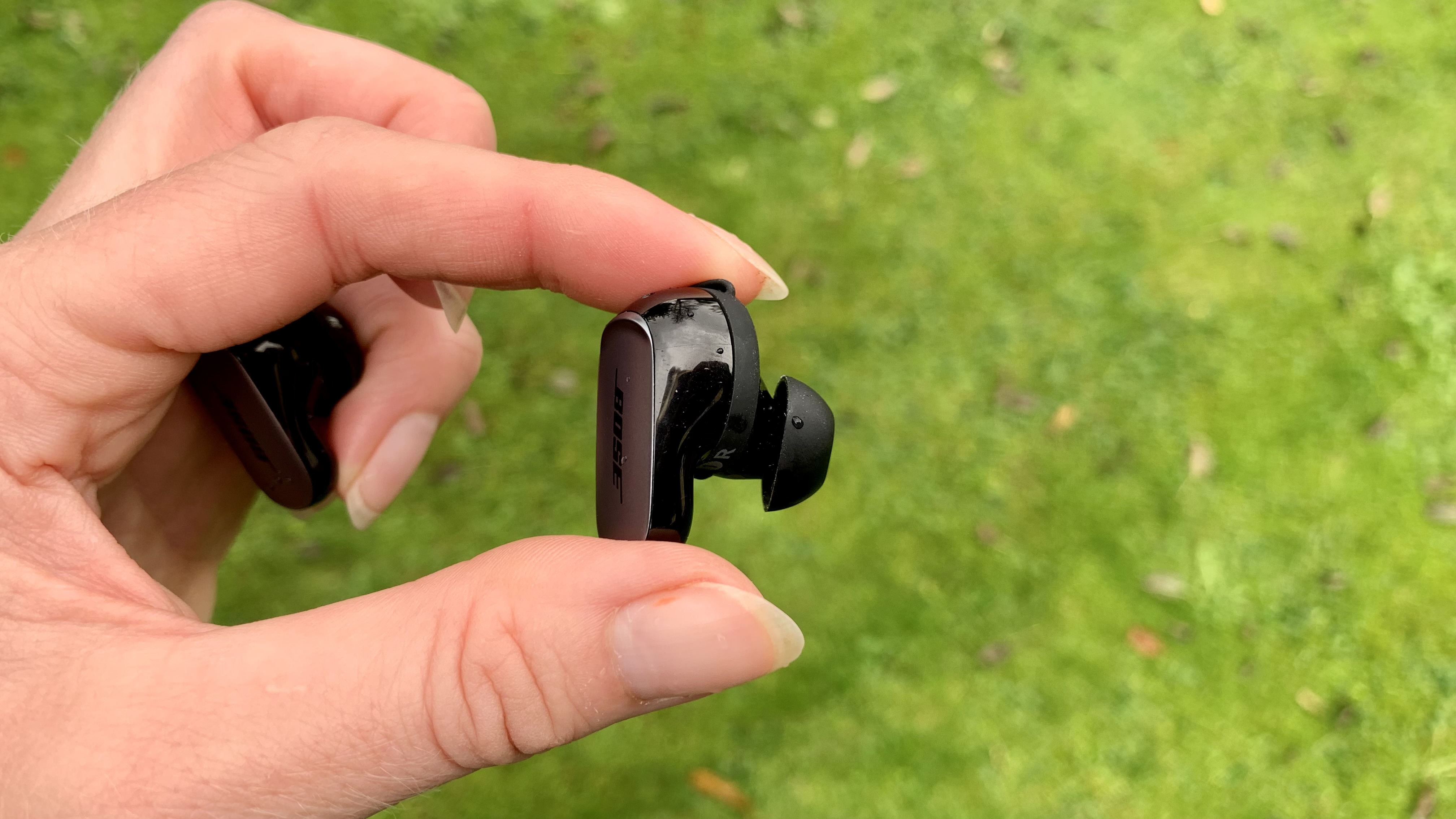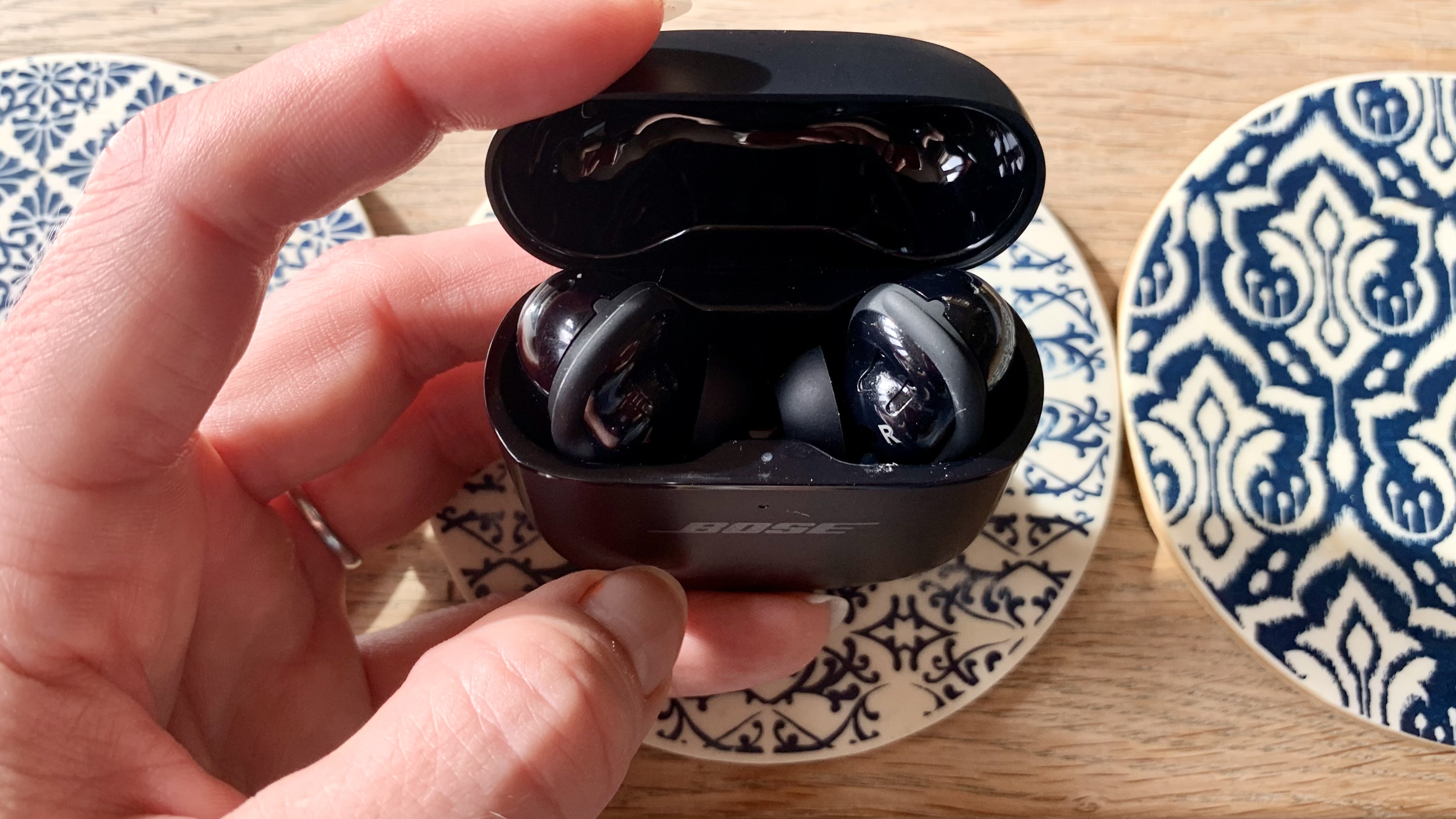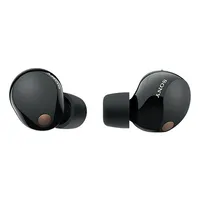TechRadar Verdict
Glance at the Bose QuietComfort Ultra Earbuds and you may think not much has changed in a year. And you'd be right, until we look a little deeper. Under the hood, you now get Snapdragon Sound certification with aptX Adaptive support, plus Bose's all-new Immersive Audio to create an expansive, moving soundstage around you. So why no five-star review? At this level, we'd expect wireless charging as standard in 2023, and while the sound is as vigorous as the 2022 buds they're built on, it can now be bettered for similar money – as can the slightly bulky build.
Pros
- +
Excellent device-agnostic head-tracked immersive audio
- +
Lossless audio codec support
- +
Still the best noise-cancelling in a set of earbuds
Cons
- -
Case cannot charge wirelessly unless you buy a cover
- -
Physically very similar to the QCE II
Why you can trust TechRadar
Editor's Note
• Original review date: October 2023
• A software update in July 2024 added multipoint to two devices
• Launch price: $299 / £299 / AU$449
• Target price now: $220 / £199 / AU$399
Update: November 2024. The headline-grabber here has always been the device agnostic spatial audio-meets-active noise cancellation profiles. These are excellent. They're unlike anything offered by the competition and they're what made Bose's inaugural Ultra Earbuds worthy of inclusion in many of our earbuds buying guides. Only, we hung back on that for a while. Why? The lack of multi-point connectivity at launch, the fact that they can't charge wirelessly unless you buy a separate cover for the case, and the high price tag made us stick with the cheaper (and let's face it, still very similar) QCE II.
Now though, those last two issues have been resolved: a July 2024 software update brought with it multi-point support to two devices, and time has brought those typically-Bose prices down – so here we are, recommending them with renewed vigour. The bulk of this review remains unchanged, but know these updates now.
If you love the shape and fit of the older QuietComfort Earbuds 2 you'll love it here – they look and feel very similar indeed. And now that the spatial audio and ANC wizardry is more financially accessible, there's a lot to celebrate…
Bose QuietComfort Ultra Earbuds: two-minute review
To save you the bother of checking, you are indeed reading about the Bose QuietComfort Ultra Earbuds, Bose's newest and Ultra-suffixed set of buds. But yes, they do look remarkably similar to the 2022-issue best noise cancelling earbuds in the business, the now-outgoing QuietComfort Earbuds 2.
Given that fact, you might be thinking 'Well, that's good, surely! Five stars back then, five stars now, right?'
The thing is, this race isn't getting any easier to win. If you were expecting a design overhaul to warrant a new Ultra iteration only a year after the older model launched, you'd be disappointed. Aside from the outer-facing surface of the stems, which is now shinier, a few tweaks of the four-mics-per-bud array to promote better calls (they are indeed clearer and better this time around) and a massage of the silicone stability bands, which are now a lot easier to fit thanks to new grooves on the earbuds, there's little to write home about physically.
Sign up for breaking news, reviews, opinion, top tech deals, and more.
For most of us, these earbuds will fit fairly well (you get three stability bands around the driver housing and three separate tips to choose from), but I do agree with TR's Sharmishta Sarkar in that I too wish Bose could have come up with an alternative to wedging 'buds in with stability bands because these silicone accessories wear out and thus, the seal is compromised.
But physical design is only half the story. Under the hood, Bose's trump card and reason for the Ultra moniker is its own all-new Immersive Audio technology. And that means truly device-agnostic, head-turning, belly-laughter-inducing joy where musical strands within tracks present themselves either all around you, or slightly in front of your temples, depending on which Mode you select.
Thanks to the Snapdragon Sound Suite, you now get aptX Adaptive support on the menu too. Sonically, they're the same vigorous and engaging listen as the QCE II they supersede, and although we might have hoped for an extra ounce of dynamic nuance and detail in our music, the active noise cancellation is still top of the heap.

All glowing praise, so why the very good rather than excellent verdict? A few reasons. When the QCE II launched in September 2022, we'd yet to meet the Technics EAH-AZ80, which arrived in May 2023 offering very clear calls, a poised and revealing sound plus multipoint connectivity to three devices. Yes, three. How many devices can the new flagship Bose QuietComfort Ultra Earbuds connect to simultaneously? One. While it may seem a small issue, anyone familiar with the ease multipoint connectivity brings to your working day (answering your phone, back to your laptop for a Zoom call, reverting to the WhatsApp audio message on your phone – all without manually altering your earbuds' source) will miss it sorely here.
Then, there's the omission of wireless charging on the spec sheet. Both the Technics and the July 2023-issue Sony WF-1000XM5 can charge wirelessly from the box. Now, Bose can sell you a cover for the case (which will also work for the QCE II) to allow it to charge wirelessly, but at $49 / £49 / AU$79 it rather ups the asking price to get a similarly specified proposition, no?
A little on Bose's new Immersive Audio and the Modes tab then, (because these can be a little confusing in an otherwise very intuitive app experience): if you simply select 'Quiet' under the Modes menu, you'll get maximum ANC but Immersive Audio will switch off. Same with 'Aware' – and that's a shame because this little setup can do so much more. The 'Immersion' mode sets ANC to its highest and also plays immersive audio in the Motion setting – so, the three-dimensional presentation moves with you as you turn your head, rather than fixing your source device as a reference point.
But my favorite Mode by far is entitled (perhaps bizarrely) 'Work' – although you can set up your own Modes too – because here, you get the Holy Grail: a ten-increment ANC slider and the option to have Immersive Audio either Off, Still (fixed) or in Motion (moving with you). Deploy this, set Immersive Audio to 'Still' and I promise you'll think you're not wearing earbuds. You'll also think your laptop just got much better at playing music.

Finally, (and let me be clear, the noise cancellation here is the most effective you'll find in a set of earbuds; top of the class) the sound quality is marginally beaten for detail and dynamic rise and fall by the Sony and Technics options. That's not to say the Bose QuietComfort Ultra Earbuds are a bad listen, far from it, but competition is fierce at this level and for that extra ounce of dynamic build through the leading edges of notes, they've been bettered.
I heard new backing vocals being brought forward to my left ear in Hootie & the Blowfish's Hold My Hand as I turned my head. Across the course of my listening, I also heard a lovely, lively, and zealous mix in Jackson Browne's The Pretender. It's only during songs such as Rod Stewart's Sailing that you notice it; so energetic is the Bose QCUE's performance, it doesn't start out quietly and delicately enough, nor does the mix build as pensively as it should.
Then again, near-audiophile quality music doesn't have to be your top priority here. Perhaps you take regular flights and want something portable that creates a near bubble of silence around you, plus music? That's what you'll get here. Note that although the QCUE's battery life can suffer for it (and you're only getting six hours in a best-case scenario anyway, before the case is required) the noise cancellation here is excellent; emphatically your best bet for nixing cabin noise and keeping your carry-on baggage to a minimum.
Bose QuietComfort Ultra Earbuds review: Price & release date
- Officially priced $299 / £299 / AU$449
- Launched September 2023
Bose QuietComfort Ultra Earbuds will officially set you back $299 / £299 / AU$449 and they became available in mid-October, having launched on September 14, 2023.
This pricing is pretty close to Sony's 2023 flagship WF-1000XM5, depending on where you're buying ($299.99 / £259 / AU$499) and the excellent Technics EAH-AZ80 (which boast triple-device connectivity and some of the best call quality we've ever experienced, also at $299 / £259 / AU$499).
Remember though, if you want wireless charging, you'll need to shell out an extra $49 / £49 / AU$79 for a cover to slip over your Bose QCUE case – so it's starting to add up to a typically Bose price tag.
Bose has kept it simple with a tried and tested launch price, releasing the QuietComfort Ultra Earbuds with the same MSRP as the five-star, September 2022-issue Bose QuietComfort Earbuds II, ($299 / £279 / AU$429), but given the standard of the competition in 2023 – and the few key omissions on the spec sheet – is it a gamble?
Yes and no. The aces up Bose's sleeve are the exemplary levels of ANC and Immersive Audio – but it's impossible to ignore the basic battery life and connectivity omissions, which makes things start to look a little disappointing in direct comparison.

Bose QuietComfort Ultra Earbuds review: Specs
| Drivers | 10mm |
| Active noise cancellation | Yes |
| Battery life | 6 hours (buds) 24 hours total (with case) |
| Weight | 6.24g per earbud |
| Connectivity | Bluetooth 5.3, USB-C, aptX Adaptive, Snapdragon Sound |
| Frequency range | Not stated |
| Waterproofing | IPX4 |
| Other features | Immersive Audio, sound 'modes' |
Should you buy the Bose QuietComfort Ultra Earbuds?
| Features | Excellent ANC and Immersive Audio, but no multipoint or wireless charging | 4 / 5 |
| Sound quality | Zealous across the frequencies, marred only by a minor shortfall in dynamic build and detail | 4 / 5 |
| Design | Very little changes over the QCE II; possibly a touch large by today's standards | 4 / 5 |
| Value | A huge hit for ANC, but the fact you have to buy a cover for wireless charging does affect things | 4 / 5 |
Buy them if...
You want the best ANC earbuds on the market
For noise-nixing alone, you've found them. Select 'Work', tweak that ANC slider, set the Immersive to either 'Still' or 'Motion' and enjoy.
You want head-tracked Spatial Audio on Android
As well as aptX Adaptive, these earbuds don't care about your source device or streaming service, they'll give you fantastic spatial audio that stays put or comes with you.
You like earbuds with tails
Some users with smaller ears may find these buds a little bulky – but if you know you like to feel the gravitational pull of the tails securing them in your ears, these buds may well be for you.
Don't buy them if...
You love multipoint connectivity
No dice here sadly. There's a tab in the app for your previously connected devices, but it's strictly a one-in, one-out policy here.
You need Qi wireless charging
You can get this from Bose, but you'll have to shell out more for a cover to put over the case, whereas Sony and Technics will sell you a set of buds for the same money that does it straight from the box.
You really like smaller earbuds
At a time when every manufacturer is shaving a few grams off its earbuds with each fresh iteration, these buds do feel a touch bulky.
Bose QuietComfort Ultra Earbuds review: Also consider
| Header Cell - Column 0 | Bose QuietComfort Earbuds Ultra | Technics EAH-AZ80 | Sony WF-1000XM5 | Bose QuietComfort Earbuds II |
|---|---|---|---|---|
| Price | $299 / £299 / AU$449 | $299; £259; AU$499 | $299.99 / £259 / AU$499 | $299 / £279 / AU$429 |
| Drivers | 9.3mm | 10mm | 8.4mm | 9.3mm |
| Active noise cancellation | Yes | Yes | Yes | Yes |
| Quoted battery life | (Up to) 6h (buds); (up to) 24h (case inclusive) | (Up to) 7h (earbuds); (up to) 25h (charging case) | 8 hours (buds); 24hrs total with case | 6 hours (buds); 3 extra (charging case) |
| Weight | 6.24g per earpiece | 7g per earpiece | 4.2g per earpiece | 6.2g per earpiece |
| Connectivity | Bluetooth 5.3, aptX Adaptive | Bluetooth 5.3, LDAC | Bluetooth 5.3, LDAC | Bluetooth 5.3 |
| Frequency range | Not stated | 20Hz - 40kHz | Not specified | Not speciifed |
| Waterproofing | Yes, IPX4 | Yes, IPX4 | Yes, IPX4 | Yes, IPX4 |
| Other features | Immersive Audio | Dirac Virtuo | Sony 360 Reality Audio | CustomTune audio |
Technics EAH-AZ80
No spatial audio upmixing and they look a little deeper at first glance (they're a tad heavier), but that concha design does work and for us, they feel more secure in our ears than the Bose option. Also, you get multipoint to three devices, which is two more than the Bose QCUE offers, and sonically the Technics product also edges it – as you can read about in our full Technics EAH-AZ80 review.
Bose QuietComfort Earbuds II
Despite the name, we find the Sony WF-1000XM5 more comfortable and more discreet. However, Bose's facility with active noise-cancellation and ambient aware features is some of the best in the business – and if you're not fussed about the new-fangled Immersive Audio, there may be a few deals cropping up now that the QCUE is here. The frequent flyer’s bargain buy – potentially. Read our full Bose QuietComfort Earbuds II review.
Sony WF-1000XM5
A much smaller earpiece and a case that fits comfortably in your pocket, with all of Sony's flagship tech. That said, we don't think the adaptive noise cancellation in this particular iteration can match that of the Bose option above – or the new Bose QuietComfort Ultra Earbuds. Read more on this in our full Sony WF-1000XM5 review.
How I tested the Bose QuietComfort Ultra Earbuds

- Tested for 10 days, listened against the Bose QuietComfort Earbuds II, Technics EAH-AZ80 and Sony WF-1000XM5
- Used at work (commuting on the train; in the office; walking through London) and on the blustery Dorset seafront
- Listened to Tidal Masters, Apple Music Lossless tracks and Spotify on an iPhone 12, Sony Xperia 1 IV and a MacBook Pro
When testing earbuds or headphones, devotion to the task is key. The Bose QuietComfort Ultra Earbuds have been my musical companions for ten days solid – after a thorough 48-hour run-in period.
To better test the comfort levels (and battery life claims), I wore them throughout the working day in a busy office and on the noisy London Underground network. I also wore them in a quieter pilates class, to check the fit and security.
The Bose QuietComfort Ultra earbuds accompanied me to work on weekdays (walking brusquely to the station; boarding a train and the London Underground; at the office) and on a particularly blustery day on a secret Dorset beach searching for sea glass – a great way to test any wind-interference from mics during calls.
When testing the audio quality across the frequencies, I listened to myriad playlists (spanning everything from house-pop to classical) on Apple Music and Tidal, but also to podcasts and albums on Spotify – and YouTube clips (mostly about mudlarking on the Thames foreshore, if you want to know) from my MacBook Pro.
I’ve been testing audio products for five years now. As a classical dancer, aerialist, and musical theater performer in another life, sound quality, fit, and user experience have always taken priority for me personally – and having heard how wonderful ANC can be when done well, I know where the bar is.
- First reviewed October 2023
- Read more about how we test

Becky became Audio Editor at TechRadar in 2024, but joined the team in 2022 as Senior Staff Writer, focusing on all things hi-fi. Before this, she spent three years at What Hi-Fi? testing and reviewing everything from wallet-friendly wireless earbuds to huge high-end sound systems. Prior to gaining her MA in Journalism in 2018, Becky freelanced as an arts critic alongside a 22-year career as a professional dancer and aerialist – any love of dance starts with a love of music. Becky has previously contributed to Stuff, FourFourTwo and The Stage. When not writing, she can still be found throwing shapes in a dance studio, these days with varying degrees of success.



